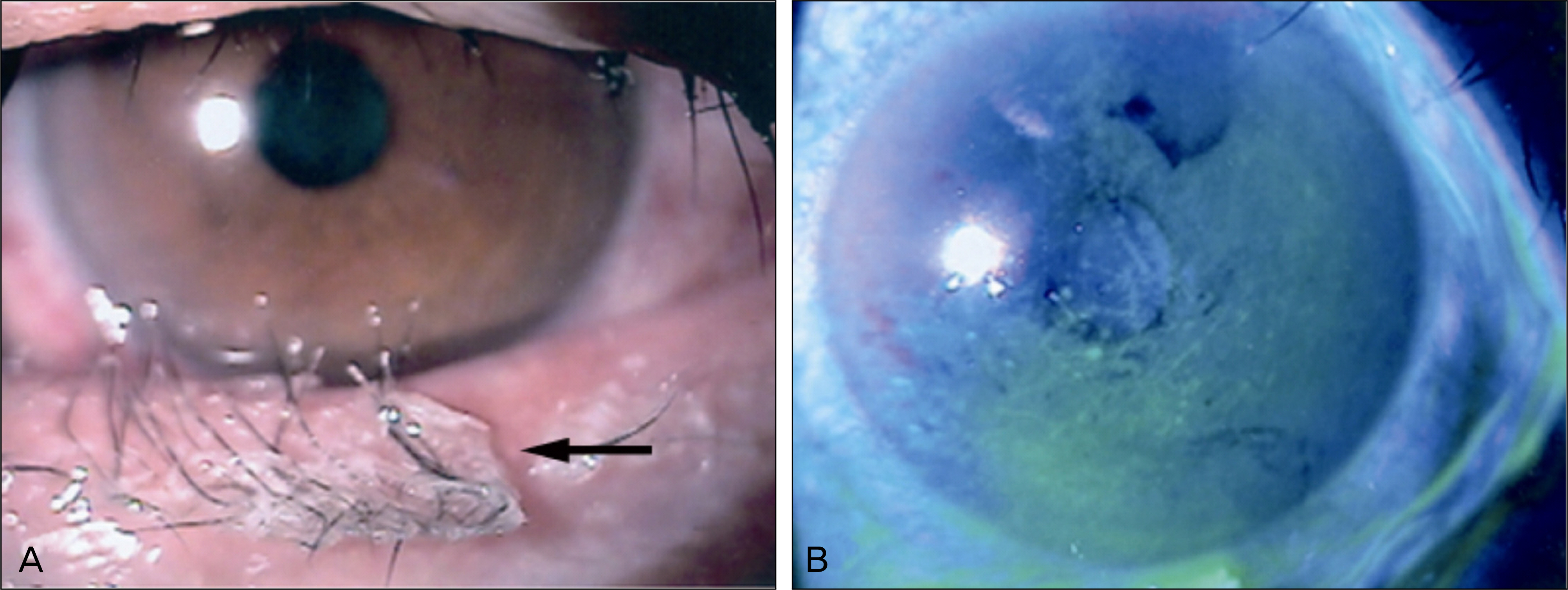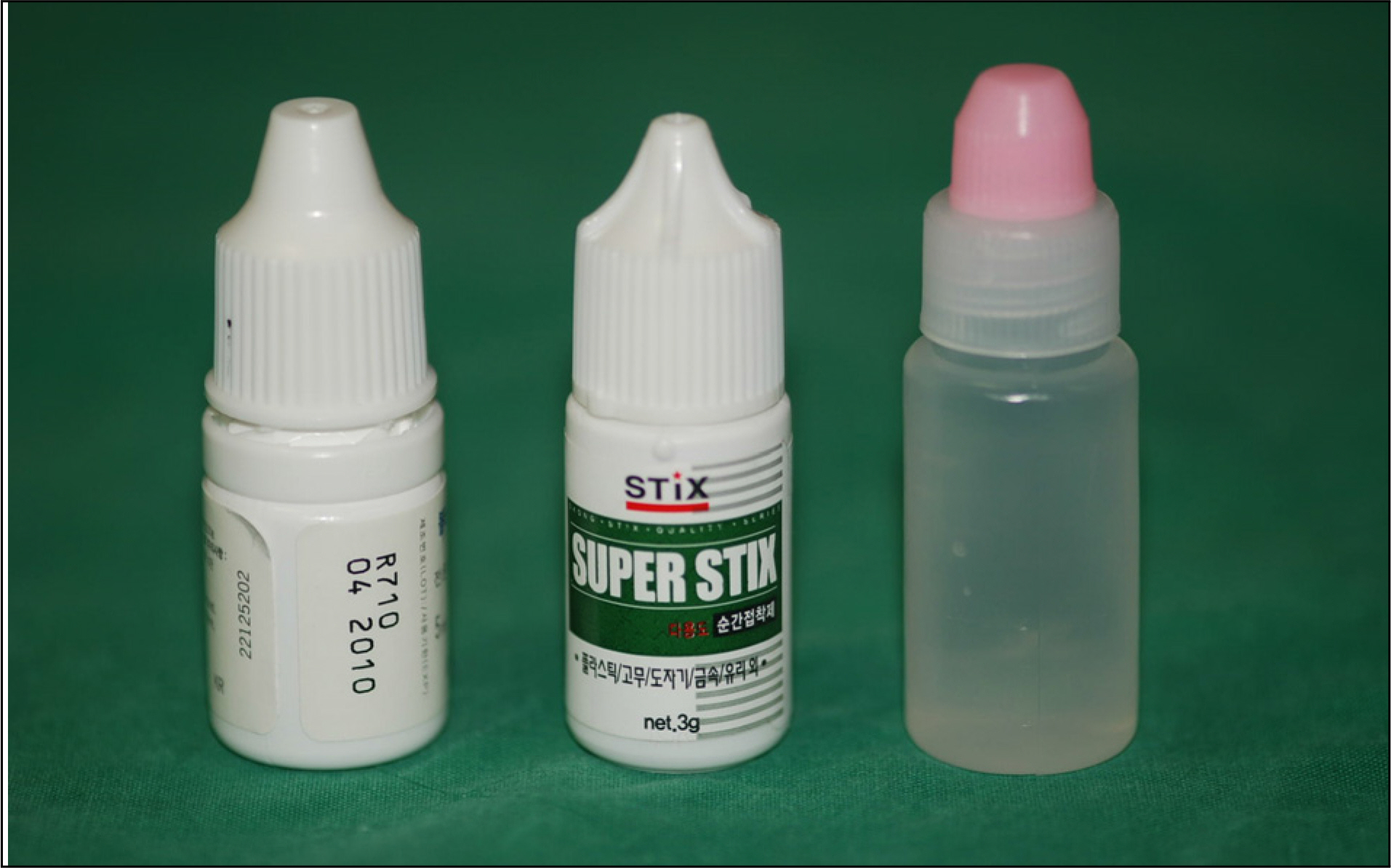J Korean Ophthalmol Soc.
2010 Oct;51(10):1398-1402.
Clinical Features and Preventions of Ocular Injuries Associated With Mistaken Use of Superglue as Eyedrops
- Affiliations
-
- 1Department of Ophthalmology, Dongguk University College of Medicine, Gyeongju, Korea. meinkamf@dongguk.ac.kr
Abstract
- PURPOSE
To investigate the clinical features and prevention of ocular injuries associated with the mistaken use of superglue as eyedrops.
METHODS
Medical records of 13 patients with ocular superglue injury who visited our hospital from January 1, 2002 to December 31, 2004 were analyzed. The clinical features of ocular superglue injury and causes of using superglue instead of eyedrops for each patient were analyzed.
RESULTS
The present study involved 15 eyes of 13 patients, including seven men (53.8%) and six women (46.2%), ranging from 6 to 72 years of age, with a mean age of 38.4 years. Ocular superglue injuries were corneal abrasion in all patients. The bonding of eyelids (eight cases, 61.5%) and eyelashes (two cases, 15.4%) were identified. Ocular injuries were treated conservatively and resolved without complications. The major cause of mistaken use of superglue was similarly packaged eye drops (11 cases, 84.6%). Other causes included poor eyesight (one case) and unsupervised children (one case).
CONCLUSIONS
The availability of eyedrops in various ocular diseases has recently increased, and superglue is found in many households, wherefore incidence of ocular superglue injuries can increase. Therefore, modifying the design of superglue bottles and providing proper education for patients to prevent ocular superglue injury is important.
Keyword
MeSH Terms
Figure
Reference
-
References
1. Campbell JK. Accidental use of superglue in the eye. Nebr Med J. 1982; 67:335–6.2. Balent A. An accidental tarsorrhaphy caused by acrylic adhesive. AM J Ophthalmol. 1976; 82:501.
Article3. Desai SP, Teggihalli BC, Bhola R. Superglue mistaken for eyedrops. Arch Dis Child. 2005; 90:1193.4. DeRespinis PA. Cyanoacrylate nail glue mistaken for eye drops. JAMA. 1990; 263:2301.
Article5. Good AM, McCabe SE. Superglue accidents and the eye–causes and prevention. Br J Ophthalmol. 1994; 78:802.
Article6. Margo CE, Trobe JD. Tarsorrhaphy from accidental instillation of cyanoacrylate adhesive in the eye. JAMA. 1982; 247:660–1.
Article7. McLean CJ. Ocular superglue injury. J Accid Emerg Med. 1997; 14:40–1.
Article8. Picton-Robinson I. Danger of instant adhesives. Br Med J. 1977; 2:581–2.
Article9. Persaud R. A novel approach to the removal of superglue from the ear. J Laryngol Otol. 2001; 115:901–2.
Article10. Wight RG, Bull PD. Superglue ear. J Laryngol Otol. 1987; 101:706–7.
Article11. Duvvi SK, Lo S, Kumar R, Spraggs PD. Superglue (cyanoacrylate) in the nose. Otolaryngol Head Neck Surg. 2005; 133:803–4.
Article12. Cousin GC. Accidental application of cyanoacrylate to the mouth. Br Dent J. 1990; 169:293–4.
Article13. Bron AJ, Evans VE, Smith JA. Grading of corneal and conjunctival staining in the context of other dry eye tests. Cornea. 2003; 22:640–50.
Article14. Maitra AK. Management of complications of cyanoacrylate adhesives. Br J Clin Pract. 1984; 38:284–6.15. Levine AM. Sutureless ocular surgery: Results of recent experiments. Eye Ear Nose Throat Mon. 1964; 43:55–8.16. Bloomfield S, Barnert AH, Kanter PD. The use of Eastman 910 monomer as an adhesive in ocular surgery. I. Biologic effects on ocular tissues. Am J Ophthalmol. 1963; 55:742–8.17. Bloomfield S, Barnert AH, Kanter P. The use of Eastman-910 monomer as an adhesive in ocular surgery. II. Effectiveness in closure of limbal wounds in rabbits. Am J Ophthalmol. 1963; 55:946–53.18. Lyons C, Stevens J, Bloom J. Superglue inadvertently used as eyedrops. BMJ. 1990; 300:328.
Article19. Raynor LA. Treatment for inadvertent cyanoacrylate tarsorrhaphy: Case report. Arch Ophthalmol. 1988; 106:1033.20. Morgan SJ, Astbury NJ. Inadvertent self administration of superglue: a consumer hazard. Br Med J (Clin Res Ed). 1984; 289:226–7.
Article



